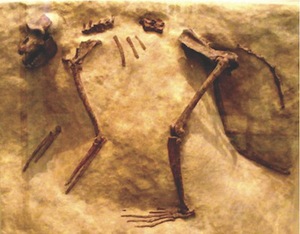 UO paleontologist Stephen Frost has an unusual skill: if handed a monkey skull from an archaeological dig, he can name the species.
UO paleontologist Stephen Frost has an unusual skill: if handed a monkey skull from an archaeological dig, he can name the species.
UO paleontologist Stephen Frost has an unusual skill: if handed a monkey skull from an archaeological dig, he can name the species.
It’s a valuable skill because each Old World monkey fossil provides clues to the environment where the monkey lived. This is possible because many ancient monkeys, like monkeys today, were specialists. Some lived in rainforests, some in deserts and some in mountains, with each species evolving a body size, skeletal structure and teeth suited to its major food source and habitat.
 This is in contrast to fossils of hominids, a lineage that includes apes and humans. Hominids, particularly the direct predecessors of modern humans, were generalists. Though hominid species lived in many different climates, their bone structure varies much less from place to place than monkey bone structure, therefore conveying fewer clues about the ancient landscape they inhabited.
This is in contrast to fossils of hominids, a lineage that includes apes and humans. Hominids, particularly the direct predecessors of modern humans, were generalists. Though hominid species lived in many different climates, their bone structure varies much less from place to place than monkey bone structure, therefore conveying fewer clues about the ancient landscape they inhabited.
For scientists interested in human evolution, the plentiful monkey fossils often unearthed near fossils of our human ancestors provide evidence of available food sources and climatic conditions that human fossils can’t.
Frost, an associate professor of anthropology, had never planned on becoming an extinct-monkey expert. Rather, his expertise is a byproduct of his research on climate change and human evolution. He was especially interested in the “turnover pulse” hypothesis, a theory that the evolution of modern humans, and many other animals, is linked to a global cooling event that began some 2.5 million years ago—around the same time the fossil record indicates the first members of our genus, Homo (Homo habilis), emerged in East Africa.
Was evolution of the human species— with a larger brain, ability to use tools and a more complex social structure—forced by adaption to a changing climate? To test the hypothesis Frost turned to the fossil record. If the record indicated the disappearance and emergence of many new species of monkeys around the time of the global cooling, the findings would support the theory that this period of climate change also drove the evolution of humans.
But after examining thousands of monkey fossils over a period of ten years, Frost found that Old World monkey evolution was not accelerated and this therefore suggests that human evolution was not prompted by the global cooling conditions.
For Frost, the turnover pulse hypothesis had been put to rest. His interest in Old World monkey fossils, however, has not.
As one of only a few paleontologists in the world with specific expertise in monkey fossils, he serves as a valuable member of the scientific team on some high-profile archaeological digs.
His most recent project: identifying monkey bones at the Gona paleoanthro- pological site in Afar, Ethiopia, in the same region as the dig sites that uncovered both Lucy (3.2 million-year-old hominid) and Ardi (4.4 million year-old hominid). The Gona Project has so far uncovered a 1.2 million-year-old Homo erectus pelvis, as well as 4.5 million-year-old hominids and the world’s oldest stone tools (2.6 million years old). Frost hopes his work in Gona and other areas will assist in recreating an idea of the landscape that our human ancestors inhabited.
—Patricia Hickson






 study by UO economists, released just before the Rose Bowl, has been picked up by the media far and wide.
study by UO economists, released just before the Rose Bowl, has been picked up by the media far and wide.